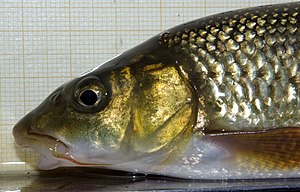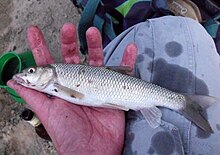Luciobarbus graellsii
| Luciobarbus graellsii | ||||||||||||
|---|---|---|---|---|---|---|---|---|---|---|---|---|

Head part of Luciobarbus graellsii |
||||||||||||
| Systematics | ||||||||||||
|
||||||||||||
| Scientific name | ||||||||||||
| Luciobarbus graellsii | ||||||||||||
| ( Steindachner , 1866) |
Luciobarbus graellsii , the Germans Ebro bar called, is a species from the family of carp fish (Cyprinidae), the natural, endemic circulation area on the Iberian Peninsula is located. Belonging to the genus Luciobarbus or Barbus is still controversial and has not been finally clarified.
description
Luciobarbus graellsii can be up to 80 centimeters long and reach an age of 16 years. The largest specimen caught with a rod was caught in the Ebro in 2008 and weighed three kilograms and was 60 centimeters long. The greyish green back goes over the whitish yellow flanks into the white belly. The edge of the dorsal fin is straight or slightly concave, the attachment of the dorsal fin is slightly in front of the pelvic fins. The tail stalk is broad.
The peritoneum is black. The number of scales on the sideline is 43 to 51. The last undivided fin ray is thin, its rear side is not sawed in adults , and in specimens smaller than 15 centimeters SL occasionally little sawed at larger intervals. The barbels are relatively long, the back barbels extend beyond the back of the eyes. The lower lip is widened and covers the tip of the lower jaw, there is no middle lobe (median lobe).
distribution
The distribution area is limited to the geographical coordinates 44 ° N - 41 ° N, 5 ° W - 0 °. Luciobarbus graellsii is originally native to the northeast of Spain . Its main distribution area is on the Mediterranean side of the Ebro and Ter in Catalonia . Furthermore, the fish species occurs on the Atlantic side in the river basin of the Río Asón in Cantabria . Luciobarbus graellsii was introduced in Italy around 1998 . In Tuscany , the barbel species spread in the Albegna , Fiora and Ombrone rivers . After an investigation in 2013, the species is now also established in the Tiber . Possibly released illegally by fishermen, it is in competition with the endemic Italian barbel that is native there . There is a risk that Luciobarbus graellsii will hybridize with the Italian barbel . It also occurs in Andorra and southern France .
Habitat and way of life
The barbel is mostly found in the middle and lower reaches of rivers with moderate currents. It prefers bank areas with thick vegetation and shelters.
Luciobarbus graellsii is omnivorous , but feeds mainly on large aquatic invertebrates such as mosquito larvae and the New Zealand pygmy snail , as well as plants and algae . The spawning season takes place from spring to summer in the months of May to August. The sexually mature fish migrate upstream to their spawning grounds, which are located in fast-flowing and narrow sections of water with a gravel or rock bottom. The fish become sexually mature at around four years of age and an average length of 15 to 20 centimeters.
Taxonomy
Luciobarbus graellsii was first described by Steindachner as Barbus graellsii . Doadrio (1990) placed the Iberian barbel of the genus Barbus in the subgenus Barbus and Luciobarbus . Bianco (1998) later divided the European barbel into the genera Barbus and Messinobarbus according to morphological and ecological data . However, the genera largely agree with the subgenus Doadrios, so that Messinobarbus must be regarded as a synonym of Luciobarbus . Some authors now regard Barbus and Luciobarbus as genera.
Endangerment status
The species is considered common, the IUCN classifies Luciobarbus graellsii as not endangered (LC, Least Concern).
Individual evidence
- ↑ a b c d e Luciobarbus graellsii on Fishbase.org (English)
- ↑ World Fishing Records Luciobarbus graellsii
- ↑ a b c Luca Buonerba, Laura Pompei, Massimo Lorenzoni: First record of Iberian barbel Luciobarbus graellsii (Steindachner, 1866) in the Tiber River (Central Italy). 2013, in: BioInvasions Records , Volume 2, Issue 4. ( Online )
- ↑ a b c A. Salvador: Barbo de Graells - Luciobarbus graellsii. In: Enciclopedia Virtual de los Vertebrados Españoles. 2013, Museo Nacional de Ciencias Naturales, Madrid. ( Online )
- ↑ a b c d Luciobarbus graellsii in the Red List of Threatened Species of the IUCN 2017-1. Posted by: J. Freyhof, M. Kottelat, 2008. Retrieved June 23, 2017.
- ↑ I. Doadrio, YES Carmona, A. Machordom: Haplotype Diversity and Phylogenetic Relationships Among the Iberian barbels (Barbus, Cyprinidae) Reveal Two Evolutionary lineages. In: Journal of Heredity , 2002, 93 (2), pp. 140-147. ( Online )
- ^ Hugo F. Gante: Diversification of Circum-Mediterranean Barbels. In: Changing diversity in changing environment , 2011, p. 284. ( Online )
Web links
- Luciobarbus graellsii on Fishbase.org (English)
- Luciobarbus graellsii inthe IUCN 2017-1 Red List of Threatened Species . Posted by: J. Freyhof, M. Kottelat, 2008. Retrieved June 23, 2017.

